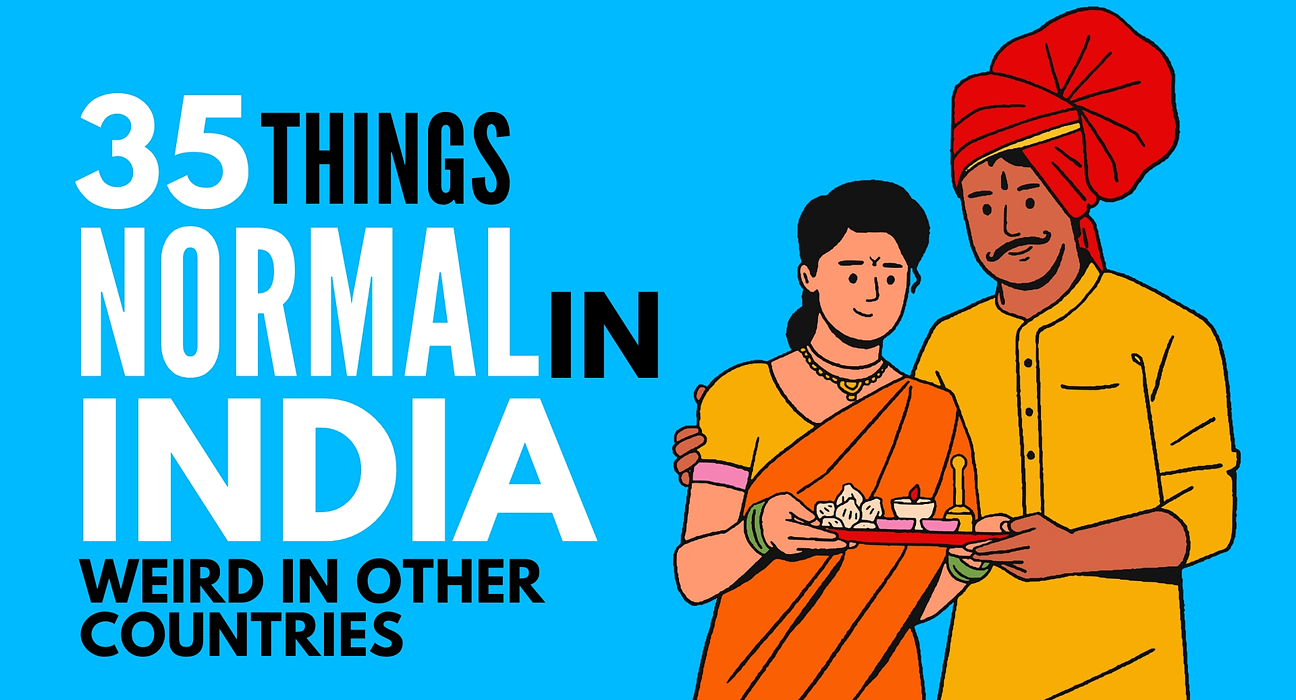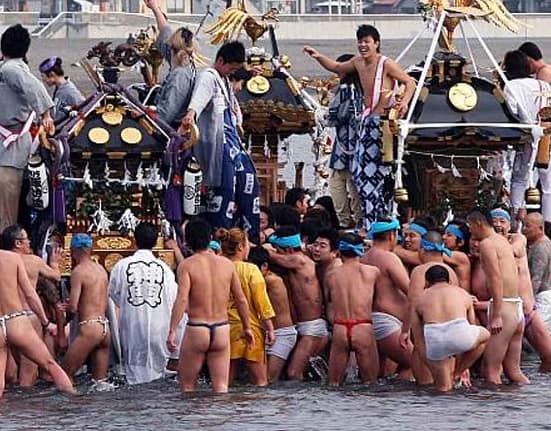In this blog post, we’re going to explore “35 Things Normal in India and Weird in Other Countries,” highlighting the weird facts about India that make Indian culture so unique.
So, let’s begin.
1: Eating with Hands

In India, eating with hands is considered a traditional and culturally rich practice. Many believe that using hands enhances the sensory experience of the food, connecting the eater with the meal on a deeper level. Each finger has a specific role in managing different types of food, and it’s often seen as a way to enjoy the meal fully.
However, in many Western cultures, using hands for eating is associated with a lack of hygiene and is often viewed as inappropriate for formal dining settings. The reliance on utensils like forks and knives is seen as more civilized and hygienic, leading to a cultural divide in dining etiquette.
2: Touching Feet of Elders
The act of touching the feet of elders is a profound sign of respect and reverence in Indian culture, reflecting the importance of familial bonds and the wisdom that comes with age. This practice is deeply embedded in Hindu tradition and signifies humility and gratitude.
Conversely, in many Western cultures, such a display might be seen as overly subservient or unnecessary, given the more casual approach to intergenerational relationships. In these societies, respect is often expressed through conversation and acknowledgment rather than physical gestures.
3: Writing in Train Toilets
In Indian public train toilets, the presence of explicit drawings, sexual imagery, adult language, and inappropriate content like phone numbers purported to be of prostitutes reflects a troubling mindset. This behavior is against cultural and social values, displaying a lack of respect for public spaces.
Unlike in India, such acts are not commonly seen in other parts of the world, where there are stricter norms and legal repercussions for vandalism. This practice highlights the need for greater awareness and respect for maintaining the dignity of shared environments.
4: Use of Water Instead of Toilet Paper

In India, it is customary to use water for personal hygiene after using the toilet, typically with a handheld bidet or a “lota” (a small water vessel). This practice is believed to be more hygienic and environmentally friendly compared to toilet paper.
However, individuals from cultures where toilet paper is the norm may find this method unfamiliar and uncomfortable, leading to a sense of awkwardness in situations where they encounter it for the first time.
5: Cows Roaming Freely in Cities
Cows hold a sacred status in Hindu culture, and their presence in Indian cities is a common sight, often wandering freely through traffic and crowds. This practice is rooted in cultural and religious beliefs, where cows are respected and not seen as mere livestock.
However, in most other countries, livestock is kept in rural areas or designated farms, and their presence in urban settings would be considered chaotic and inappropriate. This stark contrast highlights the different cultural values surrounding animals and their roles in society.
6: Arranged Marriages
In India, arranged marriages are a longstanding tradition where families play a significant role in selecting a partner based on various factors such as compatibility, social status, and even astrological charts. This practice is often rooted in cultural values that prioritize familial bonds and societal stability.
In contrast, many Western societies emphasize individual choice and romantic love in marriage, viewing arranged marriages as archaic or oppressive. The perception of autonomy in choosing a partner is highly valued in these cultures, leading to differing views on the concept of marriage.
7: Removing Shoes Before Entering Homes

The tradition of removing shoes before entering a home is deeply ingrained in Indian culture, viewed as a sign of respect and cleanliness. While this practice is common in some other Asian cultures, it can feel strange to visitors from Western countries where wearing shoes indoors is typical.
For those not accustomed to this custom, it may seem excessive or unnecessary, leading to potential discomfort during visits.
8: Joint Family Living Arrangements
The concept of joint families, where multiple generations live together under one roof, is prevalent in India. This arrangement fosters strong familial bonds and shared responsibilities but can seem crowded and lacking in privacy to individuals from cultures that prioritize nuclear families and individual independence.
In many Western societies, the emphasis is placed on personal space and privacy, which can lead to a stark contrast in living arrangements and family dynamics.
9: Public Displays of Male Affection
In India, it is not uncommon for men to hold hands or embrace in public as a sign of friendship and camaraderie. This practice reflects cultural norms that embrace close male friendships.
However, in many Western cultures, such displays are often associated with romantic relationships, leading to potential misunderstandings or discomfort for those unfamiliar with this cultural expression of friendship.
10: Addressing Older Strangers as Uncle/Aunty
In India, it is common to address older individuals as “uncle” or “aunty” as a sign of respect and warmth, regardless of whether there is a familial relationship. This practice fosters a sense of community and familial connection.
However, in many Western cultures, using such terms for non-relatives can seem overly familiar or inappropriate, as more formal modes of address (such as Mr., Mrs., or Ms.) are typically preferred. This difference highlights varying cultural norms surrounding respect and social interactions.
11: Drinking Chai (Tea) Multiple Times a Day

The ritual of consuming chai multiple times a day is deeply ingrained in Indian culture, serving as a moment for socializing and hospitality. Offering tea to guests at any time is a customary practice that emphasizes warmth and hospitality.
In contrast, in countries where tea consumption is less prominent, such frequent tea breaks may seem excessive or unnecessary, reflecting differing cultural attitudes toward beverage consumption and social rituals.
12: Use of Spices in Most Dishes
Indian cuisine is renowned for its bold and liberal use of spices, which are integral to flavoring a wide variety of dishes, including breakfast. For those accustomed to milder flavors, the intensity and complexity of Indian spices can be overwhelming.
This stark contrast in culinary practices underscores the diversity of taste preferences across cultures and highlights how the use of spices can shape the overall dining experience.
13: Public Urination
In India, public urination, particularly among men, is more commonly observed due to a combination of cultural and infrastructural factors, including a lack of public restrooms in many areas. While not officially condoned, it is often overlooked in certain contexts.
In contrast, public urination is typically illegal and socially unacceptable in many Western countries, where adequate sanitation facilities are expected in public spaces. This difference reflects varying societal norms and expectations regarding public behavior and hygiene.
14: Head Massage at Barber Shops
In India, it is common for barbershops to offer a head massage as part of a standard haircut service. This practice is rooted in the cultural appreciation for relaxation and personal care. However, individuals from cultures where such intimate contact from strangers is less common might find this surprising or uncomfortable.
The inclusion of a head massage highlights differing cultural attitudes towards personal grooming and the level of physical contact that is socially acceptable.
15: Home Ownership and Saving for Children
In Indian culture, owning a home and saving for children’s future are considered the ultimate achievements of one’s life. These goals are deeply rooted in the values of family security and long-term stability, becoming the primary focus for many individuals.
While globally, people may aspire to various life experiences or prioritize personal satisfaction, in India, these objectives often dominate financial planning and major life decisions, reflecting their significance as the pinnacle of personal success.
16: Flexible Concept of Time

In India, there is often a relaxed attitude towards punctuality, colloquially referred to as “Indian Standard Time.” This cultural tendency to accept delays and a more flexible understanding of time can be frustrating for individuals from cultures that value strict adherence to schedules and punctuality.
In many Western societies, being late is often seen as disrespectful or unprofessional, highlighting the contrasting attitudes towards time management and scheduling across cultures.
17: Intrusive Media Coverage
In India, the aggressive approach of the media towards celebrity coverage often resembles a mindset where every journalist feels entitled to capture every aspect of a celebrity’s life. This stems from a less developed legal framework for protecting celebrity privacy. While paparazzi culture is prevalent worldwide, the lack of clear legal boundaries and enforcement in India enables more intrusive coverage.
This contrasts with countries like the United States, where the right of publicity gives celebrities more control over their public image, or the United Kingdom, where privacy laws provide some protection against media intrusion.
18: Use of English Words in Local Languages
The blending of English words into local languages, such as Hindi (Hinglish) or Tamil (Tanglish), is a common practice in India. This linguistic fusion reflects the country’s colonial history and the growing influence of English in contemporary society.
However, this mixing can be confusing for non-Indians or language purists who may struggle to understand conversations filled with English terms. The phenomenon illustrates the dynamic nature of language and how cultural influences can reshape communication practices.
19: Applying Turmeric for Beauty and Health
Turmeric is widely used in India for its numerous health and beauty benefits, including its anti-inflammatory and antibacterial properties. The application of turmeric paste on the face or body, particularly during pre-wedding rituals or skincare routines, is a common practice.
However, for those unfamiliar with its benefits, the use of turmeric might seem messy or strange, especially given its bright yellow color that can easily stain skin or clothing. This difference in beauty practices highlights varying cultural approaches to skincare and wellness.
20: Eating Paan After Meals

Paan, made from betel leaves and various fillings, is often chewed after meals in India as a digestive aid and mouth freshener. The practice can leave a telltale red stain on teeth and lips, which may be off-putting for those unaccustomed to it.
While considered a cultural delicacy and a social norm in India, the sight of individuals chewing paan and its associated aesthetics can be surprising or unappealing to visitors from cultures where such practices are not common.
21: Spontaneous Home Visits
In Indian culture, it is common to drop by friends’ or relatives’ homes unannounced, reflecting a sense of community and openness. This practice emphasizes the importance of relationships and hospitality. However, in societies where visits are typically planned in advance, such spontaneous home visits may be perceived as intrusive or disrespectful of personal space and privacy.
This cultural difference highlights the varying norms surrounding social interactions and the expectations of hospitality across different contexts.
22: Use of Pressure Cookers
Pressure cookers are a staple in Indian kitchens, valued for their ability to cook food quickly and efficiently while retaining flavors and nutrients. Their distinctive whistling sound is familiar to many households.
However, in countries where pressure cookers are less common or viewed with caution due to safety concerns, their frequent use may seem unusual. This cultural difference highlights variations in cooking practices and preferences across different societies.
23: Burning Incense Daily
The daily practice of burning incense sticks in Indian households serves both religious and aromatic purposes, creating a calming atmosphere and inviting auspicious energies. However, for individuals from cultures where this practice is not common, the strong scents can be overwhelming, and concerns about fire safety may arise.
This cultural difference underscores the diverse ways in which people engage with spirituality and create ambiance in their living spaces.
24: Traffic Rules
The flexible interpretation of traffic rules in India is a stark contrast to the structured and strictly enforced traffic systems in many other countries. The use of horns as a form of communication, the frequent disregard for lane discipline, and the creative navigation of congested roads are deeply ingrained in Indian driving culture.
This behavior would be considered not only chaotic but also dangerous and illegal in countries with stricter traffic enforcement, particularly in Europe where road safety is a top priority.
25: Celebration of Numerous Festivals
India is known for its vibrant and diverse array of festivals, often celebrated with great enthusiasm and elaborate rituals. The sheer number of festivals, which can lead to frequent public holidays, may seem excessive to individuals from countries with fewer cultural celebrations and less emphasis on communal festivities.
This cultural richness reflects the importance of tradition, community, and spirituality in Indian society, contrasting with more subdued celebration practices in other cultures.
26: Eating Sweets

The Indian tradition of integrating sweets into meals or consuming them immediately after is deeply rooted in cultural and religious practices. Sweets in India, known as “mithai,” are not just desserts but are considered auspicious and are an integral part of celebrations and rituals.
This contrasts with many Western cultures where deserts are often seen as occasional treats or indulgences. The practice of starting a new venture by eating something sweet for good luck would be unfamiliar in many other countries.
27: Teenagers Addressing Girls as “Maal” (meaning “goods” or “merchandise”)
In some Indian subcultures, the casual use of the term “Maal” to describe attractive young women or girls reflects a broader cultural tendency that may prioritize looks over personality. The English translation of “Maal” is “goods” or “merchandise,” which underscores the objectification implied by the term. While it can be seen as light-hearted among peers, it also carries connotations of disrespect.
In contrast, many Western cultures emphasize respect and equality in addressing individuals, where using such terminology would be viewed as derogatory and inappropriate. This difference highlights the varying perceptions of gender and respect across cultures, illustrating the importance of sensitivity in language and social interactions.
28: Honking as a Form of Communication
The frequent use of car horns in India serves as a way for drivers to communicate with each other and navigate through traffic, often used to signal presence, alert others, or express frustration.
While this practice is normal in India, it can be overwhelming and considered rude in countries where honking is generally reserved for emergencies or urgent situations. This difference in driving etiquette can be jarring for those used to quieter roadways.
29: Openly Discussing Salaries and Finances
In India, discussing personal finances, including salaries and expenses, is often more openly accepted among friends and colleagues. This transparency can foster camaraderie and mutual support. In contrast, in many Western cultures, talking about money is considered private and taboo, with an emphasis on discretion regarding financial matters.
This difference illustrates the varying cultural attitudes toward privacy and openness in discussions about personal finances.
30: Vibrant Use of Colors in Everyday Life
India is known for its bold and vibrant use of colors in clothing, architecture, and decorations, reflecting the country’s rich cultural heritage. Bright colors are often associated with joy, celebration, and spirituality.
However, visitors from cultures that favor more muted color palettes may find this exuberance excessive or garish, illustrating differing aesthetic sensibilities and cultural associations with color.
Read Also: 31 Unknown Facts about Kerala (Even for People in Kerala)
31: Head Wobble as a Gesture

The side-to-side head wobble in India is a unique non-verbal communication method used to convey a range of meanings, including agreement, acknowledgment, or understanding. Its fluidity can express a variety of sentiments based on the context.
However, foreigners may find this gesture perplexing or misinterpret it as indecisiveness or disagreement, as in many Western cultures, nodding is the standard gesture for agreement. This difference can lead to misunderstandings in cross-cultural communication, highlighting the importance of understanding local customs.
32: Lack of Personal Space in Public
In densely populated countries like India, the comfort with close physical proximity in crowded public spaces is common. People often stand close together on public transport or in queues, which can feel invasive to those from cultures that maintain larger personal bubbles and prioritize personal space.
This cultural difference can lead to discomfort and misunderstandings, especially for visitors who are accustomed to more spacious interactions.
33: Bargaining as a Shopping Norm
In India, haggling over prices is a common practice in markets and some shops, considered a skill and part of the shopping experience. The expectation to negotiate can be stressful for visitors from cultures with fixed pricing, where bargaining is often viewed as rude or confrontational.
This cultural difference can create tension during shopping interactions, as what is seen as a friendly negotiation in India may be seen as inappropriate in other contexts.
34: Colorful Wedding Attire
Indian weddings are known for their vibrant colors and elaborate attire, with brides typically donning a red dress adorned with intricate designs and embellishments, symbolizing prosperity and marital bliss. In stark contrast, Western cultures traditionally favor white wedding dresses, which represent purity and new beginnings.
This difference in wedding attire not only reflects cultural values but also the significance placed on symbolism in marriage ceremonies. The colorful and festive nature of Indian weddings showcases the country’s rich cultural heritage and the joy associated with such celebrations.
35: Street Food Culture

In India, street food is an essential part of daily life, offering a wide variety of delicious and affordable options that reflect regional flavors and culinary traditions. While street food is cherished for its taste and accessibility, it often operates outside formal health regulations, leading to concerns about hygiene.
Visitors from countries with strict food safety standards may find the casual approach to food handling alarming, as in many Western cultures, food is typically prepared in regulated environments to ensure safety and cleanliness. Moreover, with just a few cents, you can buy a full day’s meal, making it more affordable than in many other countries in the world.
Thanks for reading “35 Things Normal in India and Weird in Other Countries.” We hope these weird facts about India insights broaden your perspective and appreciation for diversity.









